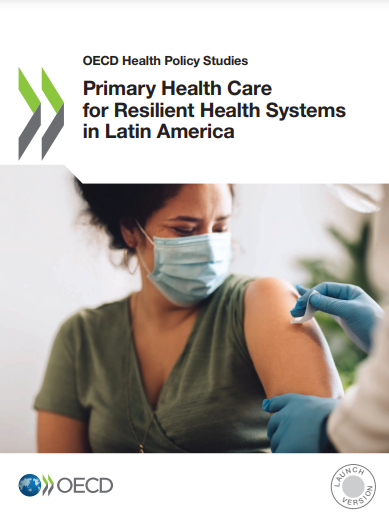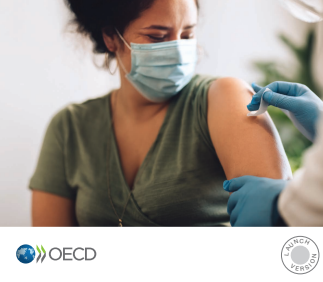Health Transformation Institute (HTI)
Joaquim Cardoso do Rosário MSc
Founder and Chief Researcher, Editor and Advisor
December 15, 2022
Executive Summary (by the Editor of the Site)
What are the achievements?
- Seven Latin American countries, Argentina, Brazil, Chile, Colombia, Costa Rica, Mexico and Peru (LAC-7) have made great efforts to strengthen their primary health care systems over the past decades.
- This contributed to some important health outcomes.
(1) Life expectancy at birth has increased in LAC-7 countries, reaching 77.9 years on average in 2020 (a gain of almost 3 years since 2000 compared to 3.6 years across other OECD countries).
(2) Infant mortality has been halved over the past two decades, going from 21 deaths per 1 000 live births in 2000 to 10.8 in 2020.
What was the impact of the pandemic?
- However, the COVID-19 pandemic inflected a large blow as shown by high rates of excess mortality in LAC-7 countries, that is, …
- … many more people died in the 2020 and 2021 in comparison with the average number of deaths in the five years before the pandemic.
- The pandemic brought additional stress to health systems that already experienced important structural challenges, …
… including a growing burden of chronic diseases, population ageing, high levels of social health inequality, under-investment and strong budgetary restrictions, and systemic inefficiencies.
What are the findings of the assessment?
- The COVID-19 pandemic revealed challenges in these LAC-7 health systems in maintaining routine care.
- Disruptions in routine vaccination, cancer screening and treatment show how primary health care systems were not resilient enough during the COVID-19 pandemic.
- Across LAC-7, for example, coverage of three doses of childhood vaccination for diphtheria, tetanus toxoid and pertussis (DTP3) at age one fell by 8% in 2020 compared to 2015–19.
- These care disruptions are likely to impose high human and financial costs, including possible exacerbation of health complications and a worsening of the population health conditions which could reverse much of the gains in well-being and health achieved during the last two decades.
What are the recommendations?
- To get ready for the future, LAC-7 countries will need to continue to expand primary health care and invest in the health workforce and the health information infrastructure.
- This is key for primary health care to be a strong first point of contact with the health system for everyone, and capable of delivering a wide range of critical health services.
- Doubling down on primary health care is a cost-effective strategy to strengthening health systems, both to increase preparedness to future pandemics and to address the structural challenges in the region.
How does LAC-7 countries compares with OECD?
- Unlike most other OECD countries, patient registration and referral systems are not fully operationalised in LAC-7 countries.
- Opportunities to provide proactive care are often being lost because primary health care does not act as the first point of care in most LAC-7 countries and many patients directly seek care in outpatient specialised clinics and hospitals.
- In all LAC-7 countries, significant gaps in performance remain across each of the three core functions:
- On primary prevention, there is scope to strengthen health promotion and vaccination.
- Brazil, Mexico, Argentina and Peru have lower vaccination coverage rates for diphtheria, tetanus toxoid and pertussis (DTP3) and for measles than other OECD countries, and there are marked socio-economic inequalities.
- In Brazil for example, vaccination coverage rates for measles and DTP3 is respectively 16% and 25% higher amongst high-income groups than low-income groups.
- 2.When it comes to secondary prevention, more could be done to improve the depth and scope of cancer screening strategies.
- Breast cancer screening in most LAC-7 countries has not reached the targets set out in the countries’ screening programmes.
- In Peru and Brazil, the breast cancer screening coverage rate is less than half the OECD average.
- 3.Inappropriate management of chronic diseases suggests ineffective tertiary prevention.
- Hospitalisations for diabetes, avoidable through strong primary health care, are relatively higher in Mexico and Costa Rica than in other OECD countries.
- LAC-7 countries also underperform compared to other OECD countries with lower cancer survival rates and higher volume of antibiotics consumption.
What are the lessons learned from the pandemic?
- Primary health care helped to mitigate the impact of COVID-19 on health in LAC-7, but access to care worsened
- Although there are significant primary health care performance gaps in LAC-7 countries, several policies and actions have been implemented to absorb the impact of the COVID-19 pandemic and recover from it:
- Primary health care has contributed to the COVID-19 emergency response.
- COVID-19 testing has been systematically carried out in primary health care in some LAC-7 countries.
- Coverage for DTP3 vaccines amongst children aged one fell by 8% in 2020 compared to the 2015–19 average.
- For cancer screening, recent evidence shows worrying disruption of screening and early detection services.
- These care disruptions will come at persistently elevated human and financial costs in the years to come, as they risk exacerbating health conditions.
What are the recommendations, about resilience?
- Increasing preparedness and resilience of LAC-7 health systems to face future high impact shocks through stronger primary health care will be critical, if the well-being and health gains achieved during the last two decades are to be maintained.
- LAC-7 countries should make primary health care the front door of the health system for everyone to deliver crucial health services.
- A stronger gatekeeping function for primary health care, with systematic patient registration and referral system, will help making individuals more resilient against COVID-19 and potential future outbreaks of infectious diseases.
- But primary health care will need the right equipment, accountability mechanisms, guidelines and trainings to perform its core functions.
- LAC-7 countries will also need to invest in health workforce planning given the existing workforce shortage.
- Lastly, investing in stronger health information infrastructure, through a consolidated system of electronic health records, is most needed to provide a good understanding of the health status and health needs of the population.
ORIGINAL PUBLICATION (excerpt)

Primary Health Care for Resilient Health Systems in Latin America
OECD
December 2022
Foreword
Seven Latin American countries, Argentina, Brazil, Chile, Colombia, Costa Rica, Mexico and Peru (LAC-7) have made great efforts to strengthen their primary health care systems over the past decades.
This contributed to some important health outcomes.
- Life expectancy at birth has increased in LAC-7 countries, reaching 77.9 years on average in 2020 (a gain of almost 3 years since 2000 compared to 3.6 years across other OECD countries).
- Infant mortality has been halved over the past two decades, going from 21 deaths per 1 000 live births in 2000 to 10.8 in 2020.
However, the COVID-19 pandemic inflected a large blow as shown by high rates of excess mortality in LAC-7 countries, that is, many more people died in the 2020 and 2021 in comparison with the average number of deaths in the five years before the pandemic.
- In Peru and Mexico, excess mortality were higher than in any other country in the world, twice to three times higher than the OECD average.
- The pandemic brought additional stress to health systems that already experienced important structural challenges, including a growing burden of chronic diseases, population ageing, high levels of social health inequality, under-investment and strong budgetary restrictions, and systemic inefficiencies.
Primary health care for resilient health systems in Latin America discusses how doubling down on primary health care is a cost-effective strategy to strengthening health systems, both to increase preparedness to future pandemics and to address the structural challenges in the region.
A conceptual framework is used to analyse the performance of primary health care across LAC-7 and identify weaknesses along three core functions:
- health promotion and immunisation;
- providing regular exams and screening to identify diseases; and
- delivering routine care for underlying health conditions.
For each of the three core functions, the report examines policies and actions that were implemented to absorb the impact of the COVID-19 pandemic, and to recover from it.
The COVID-19 pandemic revealed challenges in these LAC-7 health systems in maintaining routine care.
- Disruptions in routine vaccination, cancer screening and treatment show how primary health care systems were not resilient enough during the COVID-19 pandemic.
- Across LAC-7, for example, coverage of three doses of childhood vaccination for diphtheria, tetanus toxoid and pertussis (DTP3) at age one fell by 8% in 2020 compared to 2015–19.
- In Peru, a 50% drop in registered cancer cases was observed in 2020 when compared with the previous 4-year average,
- while in Chile treatment for cervical cancer was reduced by more than half between 2019 and 2020.
These care disruptions are likely to impose high human and financial costs, including possible exacerbation of health complications and a worsening of the population health conditions which could reverse much of the gains in well-being and health achieved during the last two decades.
To get ready for the future, LAC-7 countries will need to continue to expand primary health care and invest in the health workforce and the health information infrastructure.
To get ready for the future, LAC-7 countries will need to continue to expand primary health care and invest in the health workforce and the health information infrastructure.
This is key for primary health care to be a strong first point of contact with the health system for everyone, and capable of delivering a wide range of critical health services.

EXECUTIVE SUMMARY
Latin American countries were hard-hit by COVID-19, as shown by rates of excess mortality well above the OECD average.
The pandemic has revealed weaknesses in health systems and brought additional stress to health systems in countries that already experienced important structural challenges. Doubling down on primary health care will help strengthen health systems, both to increase preparedness to future pandemics and to address the structural challenges in the region.
A framework for understanding the performance of primary health care system
High performing primary health care systems have a strong focus on prevention. When primary health care services are the main source of care, have appropriate information to assess patients’ medical history, and are able to co-ordinate care effectively with other health services, they are well positioned to carry-out three core functions related to prevention:
1.Primary prevention, especially providing health promotion and routine vaccination;
2.Secondary prevention, including providing regular exams and screening to identify diseases; and
3.Tertiary prevention, delivering routine care for underlying health conditions.
These three core functions are critical to preparedness and resilience during health crises.
Many key linkages have been observed between core primary health care functions and the ability of countries to respond effectively to the COVID-19 pandemic, through for example the COVID-19 vaccination rollouts, the early detection of COVID-19 and the use of outreach services to manage mild COVID-19 in community and primary care settings.
Despite strong policy efforts, primary health care is not strong enough across LAC-7 countries
During the last decades, some LAC-7 countries have implemented policies to strengthen primary health care and place it at the centre of their health care strategy (such as Brazil, Chile and Costa Rica), but there is significant variation in their effective implementation.
Unlike most other OECD countries, patient registration and referral systems are not fully operationalised in LAC-7 countries.
Opportunities to provide proactive care are often being lost because primary health care does not act as the first point of care in most LAC-7 countries and many patients directly seek care in outpatient specialised clinics and hospitals.
Unlike most other OECD countries, patient registration and referral systems are not fully operationalised in LAC-7 countries.
Opportunities to provide proactive care are often being lost because primary health care does not act as the first point of care in most LAC-7 countries and many patients directly seek care in outpatient specialised clinics and hospitals.
Chile is the only country where registration with primary health care is mandatory, while in Argentina and Costa Rica patients have financial or quality incentives to do so.
In all LAC-7 countries, significant gaps in performance remain across each of the three core functions:
1.On primary prevention, there is scope to strengthen health promotion and vaccination.
Brazil, Mexico, Argentina and Peru have lower vaccination coverage rates for diphtheria, tetanus toxoid and pertussis (DTP3) and for measles than other OECD countries, and there are marked socio-economic inequalities.
In Brazil for example, vaccination coverage rates for measles and DTP3 is respectively 16% and 25% higher amongst high-income groups than low-income groups.
Brazil, Mexico, Argentina and Peru have lower vaccination coverage rates for diphtheria, tetanus toxoid and pertussis (DTP3) and for measles than other OECD countries, and there are marked socio-economic inequalities.
In Brazil for example, vaccination coverage rates for measles and DTP3 is respectively 16% and 25% higher amongst high-income groups than low-income groups.
2.When it comes to secondary prevention, more could be done to improve the depth and scope of cancer screening strategies.
Breast cancer screening in most LAC-7 countries has not reached the targets set out in the countries’ screening programmes.
In Peru and Brazil, the breast cancer screening coverage rate is less than half the OECD average.
Breast cancer screening in most LAC-7 countries has not reached the targets set out in the countries’ screening programmes.
3.Inappropriate management of chronic diseases suggests ineffective tertiary prevention.
Hospitalisations for diabetes, avoidable through strong primary health care, are relatively higher in Mexico and Costa Rica than in other OECD countries.
LAC-7 countries also underperform compared to other OECD countries with lower cancer survival rates and higher volume of antibiotics consumption.
Inappropriate management of chronic diseases suggests ineffective tertiary prevention.
LAC-7 countries also underperform compared to other OECD countries with lower cancer survival rates and higher volume of antibiotics consumption.
Primary health care helped to mitigate the impact of COVID-19 on health in LAC-7, but access to care worsened
Although there are significant primary health care performance gaps in LAC-7 countries, several policies and actions have been implemented to absorb the impact of the COVID-19 pandemic and recover from it:
- Primary health care has contributed to the COVID-19 emergency response.
Examples include primary prevention activities, efforts to create awareness on COVID-19 risks and tailor messages and information campaign on non-pharmaceutical interventions in Peru and Argentina.
Successful COVID-19 vaccination programmes were implemented at primary health care level in Chile, Argentina, Peru, Costa Rica and Brazil.
Successful COVID-19 vaccination programmes were implemented at primary health care level in Chile, Argentina, Peru, Costa Rica and Brazil.
- COVID-19 testing has been systematically carried out in primary health care in some LAC-7 countries.
In Costa Rica, all EBAIS were responsible for the detection, notification and investigation of cases, and primary health care also implemented sampling campaigns in places with an epidemiological outbreak
Despite initial delays to adapt to the health emergency, all LAC-7 countries implemented comprehensive adaptations to primary health care to advise suspected or confirmed patients in home isolation or at primary health care units when more treatment was necessary.
The Respiratory Care Modules (Módulos de Atención Respiratoria del Seguro Social, MARSS) in Mexico was responsible for treating suspected and confirmed cases of COVID-19.
However, many LAC-7 health systems faced challenges in maintaining routine care, showing how primary care systems were not resilient enough during the COVID-19 pandemic.
- Coverage for DTP3 vaccines amongst children aged one fell by 8% in 2020 compared to the 2015–19 average.
- For cancer screening, recent evidence shows worrying disruption of screening and early detection services.
- In Chile for example, cervical cancer screening coverage decreased by 20% in 2020 compared to 2015–19.
Coverage for DTP3 vaccines amongst children aged one fell by 8% in 2020 compared to the 2015–19 average.
For cancer screening, recent evidence shows worrying disruption of screening and early detection services.
These care disruptions will come at persistently elevated human and financial costs in the years to come, as they risk exacerbating health conditions.
These care disruptions will come at persistently elevated human and financial costs in the years to come, as they risk exacerbating health conditions.
Increasing preparedness and resilience of LAC-7 health systems to face future high impact shocks through stronger primary health care will be critical, if the well-being and health gains achieved during the last two decades are to be maintained.
LAC-7 countries should make primary health care the front door of the health system for everyone to deliver crucial health services.
LAC-7 countries should make primary health care the front door of the health system for everyone to deliver crucial health services.
A stronger gatekeeping function for primary health care, with systematic patient registration and referral system, will help making individuals more resilient against COVID-19 and potential future outbreaks of infectious diseases.
But primary health care will need the right equipment, accountability mechanisms, guidelines and trainings to perform its core functions.
A stronger gatekeeping function for primary health care, with systematic patient registration and referral system, will help making individuals more resilient against COVID-19 and potential future outbreaks of infectious diseases.
But primary health care will need the right equipment, accountability mechanisms, guidelines and trainings to perform its core functions.
LAC-7 countries will also need to invest in health workforce planning given the existing workforce shortage.
This requires strengthening efforts to examine needs for human resources with greater cross-sectoral collaboration, and expanding the role of some health professionals including nurses and community health workers.
Lastly, investing in stronger health information infrastructure, through a consolidated system of electronic health records, is most needed to provide a good understanding of the health status and health needs of the population.
Acknowledgements
Preparation of this report was managed by Caroline Berchet, under the supervision of Frederico Guanais.
The other authors were Marissa Berbegal Ibáñez, Gabriel Di Paolantonio, Nicolás Larraín, Ece Özçelik, and Tom Raitzik Zonenschein.
The authors also wish to thank Stefano Scarpetta, Mark Pearson and Francesca Colombo from the OECD Directorate of Employment, Labour and Social Affairs, and José Antonio Ardavín and Sofía Blamey Andrusco from OECD Global Relations.
Thanks also go to Lucy Hulett and Nathalie Corry for editorial input, to Hannah Whybrow for logistical assistance, and to Guillaume Haquin for resource management support.
The completion of this report would not have been possible without the generous support of the European Commission, the EU Regional Facility for Development in Transition and of the German Ministry of Health.
This report has benefited from the expertise and material received from several health officials and bilateral teleconferences with other health experts.
The authors are in particular grateful to María Sofía Cuba, Svetlana Doubova, Giancarlo Guevara, Soledad Martínez, Diana Pinto and Martin Sabignoso.
This report has also benefited from the comments of the Brazilian, Costa Rican, Peruvian and Mexican authorities and experts from the OECD Global Relation who reviewed earlier drafts. In particular, this includes Francisco Oviedo, Carolina Peláez Peláez, Cristina Vieira Machado Alexandre, Jimena Limay Castillo, Rolando León Rodriguez, Sofía Blamey Andrusco, Angela Ciceri and José Antonio Ardavín.
Originally published at https://www.oecd-ilibrary.org












